servicing FIAT DUCATO BASE CAMPER 2018 Owner handbook (in English)
[x] Cancel search | Manufacturer: FIAT, Model Year: 2018, Model line: DUCATO BASE CAMPER, Model: FIAT DUCATO BASE CAMPER 2018Pages: 304, PDF Size: 14.93 MB
Page 210 of 304
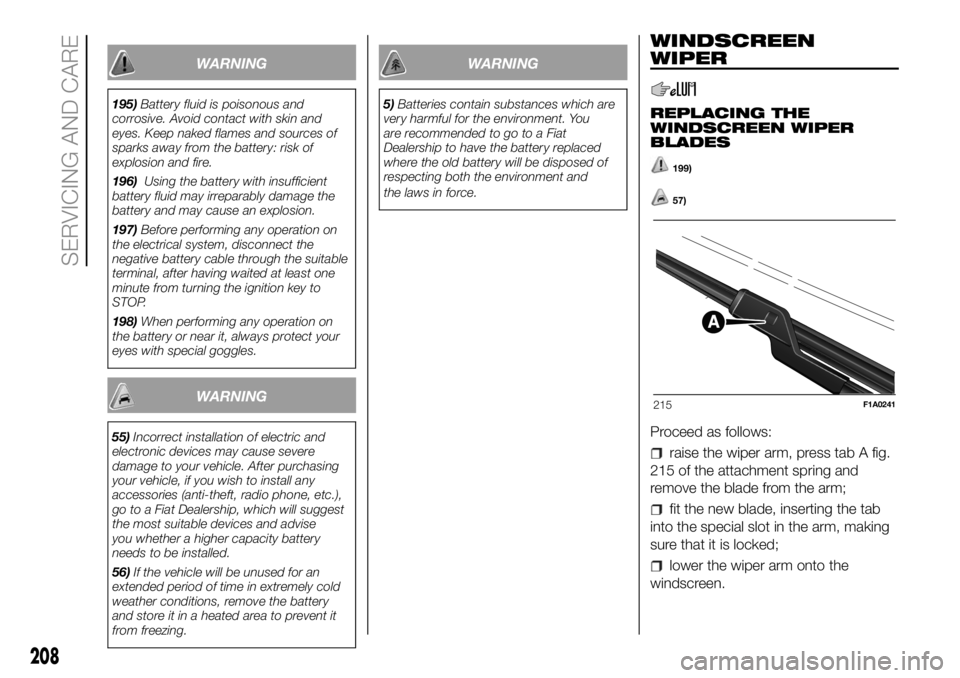
WARNING
195)Battery fluid is poisonous and
corrosive. Avoid contact with skin and
eyes. Keep naked flames and sources of
sparks away from the battery: risk of
explosion and fire.
196)Using the battery with insufficient
battery fluid may irreparably damage the
battery and may cause an explosion.
197)Before performing any operation on
the electrical system, disconnect the
negative battery cable through the suitable
terminal, after having waited at least one
minute from turning the ignition key to
STOP.
198)When performing any operation on
the battery or near it, always protect your
eyes with special goggles.
WARNING
55)Incorrect installation of electric and
electronic devices may cause severe
damage to your vehicle. After purchasing
your vehicle, if you wish to install any
accessories (anti-theft, radio phone, etc.),
go to a Fiat Dealership, which will suggest
the most suitable devices and advise
you whether a higher capacity battery
needs to be installed.
56)If the vehicle will be unused for an
extended period of time in extremely cold
weather conditions, remove the battery
and store it in a heated area to prevent it
from freezing.
WARNING
5)Batteries contain substances which are
very harmful for the environment. You
are recommended to go to a Fiat
Dealership to have the battery replaced
where the old battery will be disposed of
respecting both the environment and
the laws in force.
WINDSCREEN
WIPER
REPLACING THE
WINDSCREEN WIPER
BLADES
199)
57)
Proceed as follows:
raise the wiper arm, press tab A fig.
215 of the attachment spring and
remove the blade from the arm;
fit the new blade, inserting the tab
into the special slot in the arm, making
sure that it is locked;
lower the wiper arm onto the
windscreen.
215F1A0241
208
SERVICING AND CARE
Page 212 of 304
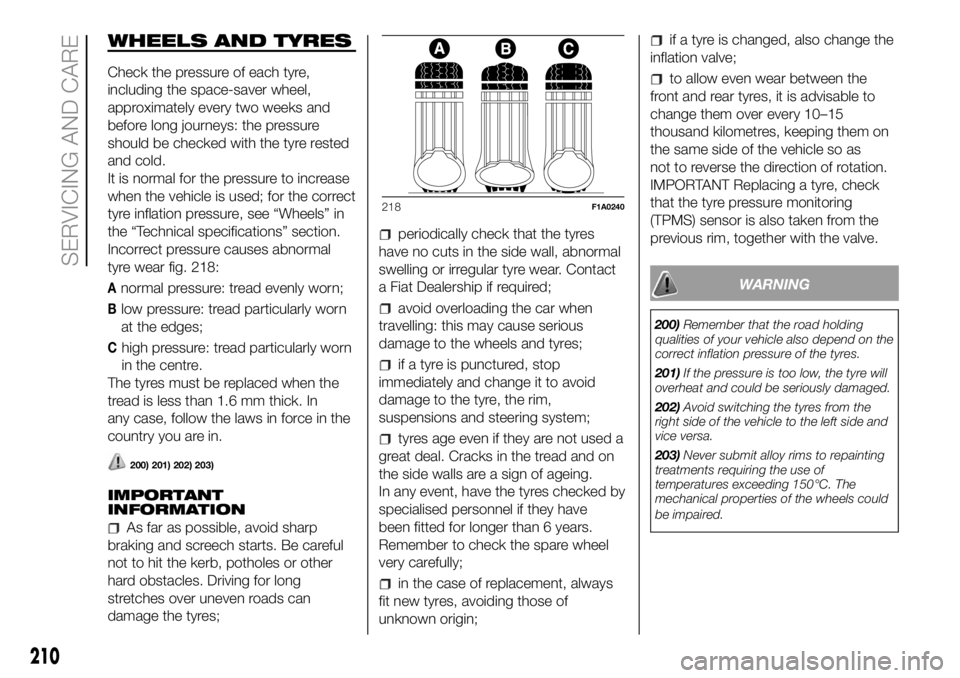
WHEELS AND TYRES
Check the pressure of each tyre,
including the space-saver wheel,
approximately every two weeks and
before long journeys: the pressure
should be checked with the tyre rested
and cold.
It is normal for the pressure to increase
when the vehicle is used; for the correct
tyre inflation pressure, see “Wheels” in
the “Technical specifications” section.
Incorrect pressure causes abnormal
tyre wear fig. 218:
Anormal pressure: tread evenly worn;
Blow pressure: tread particularly worn
at the edges;
Chigh pressure: tread particularly worn
in the centre.
The tyres must be replaced when the
tread is less than 1.6 mm thick. In
any case, follow the laws in force in the
country you are in.
200) 201) 202) 203)
IMPORTANT
INFORMATION
As far as possible, avoid sharp
braking and screech starts. Be careful
not to hit the kerb, potholes or other
hard obstacles. Driving for long
stretches over uneven roads can
damage the tyres;
periodically check that the tyres
have no cuts in the side wall, abnormal
swelling or irregular tyre wear. Contact
a Fiat Dealership if required;
avoid overloading the car when
travelling: this may cause serious
damage to the wheels and tyres;
if a tyre is punctured, stop
immediately and change it to avoid
damage to the tyre, the rim,
suspensions and steering system;
tyres age even if they are not used a
great deal. Cracks in the tread and on
the side walls are a sign of ageing.
In any event, have the tyres checked by
specialised personnel if they have
been fitted for longer than 6 years.
Remember to check the spare wheel
very carefully;
in the case of replacement, always
fit new tyres, avoiding those of
unknown origin;
if a tyre is changed, also change the
inflation valve;
to allow even wear between the
front and rear tyres, it is advisable to
change them over every 10–15
thousand kilometres, keeping them on
the same side of the vehicle so as
not to reverse the direction of rotation.
IMPORTANT Replacing a tyre, check
that the tyre pressure monitoring
(TPMS) sensor is also taken from the
previous rim, together with the valve.
WARNING
200)Remember that the road holding
qualities of your vehicle also depend on the
correct inflation pressure of the tyres.
201)If the pressure is too low, the tyre will
overheat and could be seriously damaged.
202)Avoid switching the tyres from the
right side of the vehicle to the left side and
vice versa.
203)Never submit alloy rims to repainting
treatments requiring the use of
temperatures exceeding 150°C. The
mechanical properties of the wheels could
be impaired.
218F1A0240
210
SERVICING AND CARE
Page 214 of 304
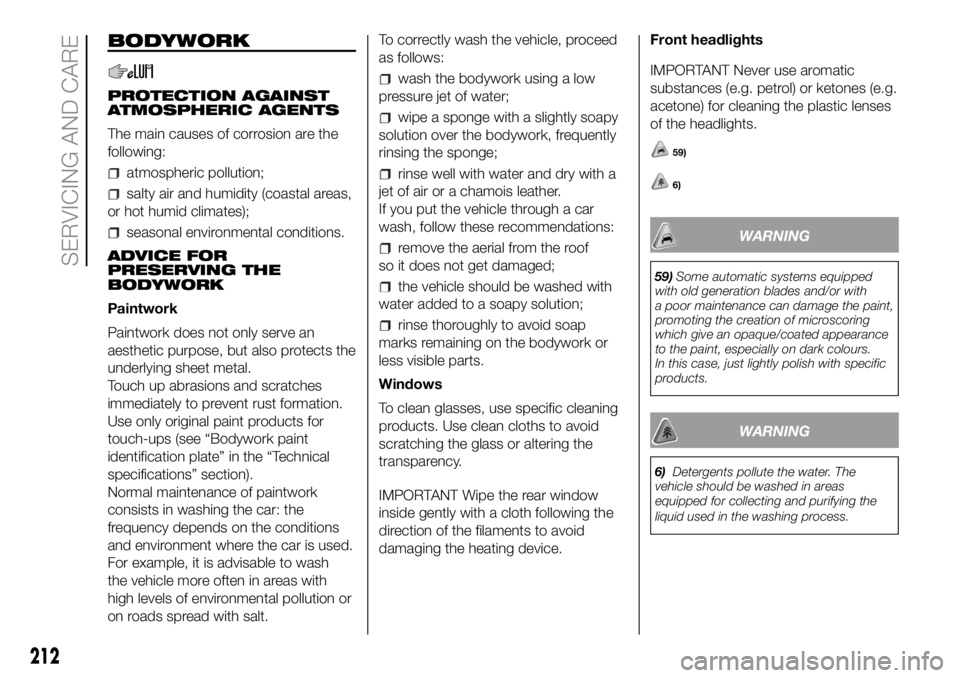
BODYWORK
PROTECTION AGAINST
ATMOSPHERIC AGENTS
The main causes of corrosion are the
following:
atmospheric pollution;
salty air and humidity (coastal areas,
or hot humid climates);
seasonal environmental conditions.
ADVICE FOR
PRESERVING THE
BODYWORK
Paintwork
Paintwork does not only serve an
aesthetic purpose, but also protects the
underlying sheet metal.
Touch up abrasions and scratches
immediately to prevent rust formation.
Use only original paint products for
touch-ups (see “Bodywork paint
identification plate” in the “Technical
specifications” section).
Normal maintenance of paintwork
consists in washing the car: the
frequency depends on the conditions
and environment where the car is used.
For example, it is advisable to wash
the vehicle more often in areas with
high levels of environmental pollution or
on roads spread with salt.To correctly wash the vehicle, proceed
as follows:
wash the bodywork using a low
pressure jet of water;
wipe a sponge with a slightly soapy
solution over the bodywork, frequently
rinsing the sponge;
rinse well with water and dry with a
jet of air or a chamois leather.
If you put the vehicle through a car
wash, follow these recommendations:
remove the aerial from the roof
so it does not get damaged;
the vehicle should be washed with
water added to a soapy solution;
rinse thoroughly to avoid soap
marks remaining on the bodywork or
less visible parts.
Windows
To clean glasses, use specific cleaning
products. Use clean cloths to avoid
scratching the glass or altering the
transparency.
IMPORTANT Wipe the rear window
inside gently with a cloth following the
direction of the filaments to avoid
damaging the heating device.Front headlights
IMPORTANT Never use aromatic
substances (e.g. petrol) or ketones (e.g.
acetone) for cleaning the plastic lenses
of the headlights.
59)
6)
WARNING
59)Some automatic systems equipped
with old generation blades and/or with
a poor maintenance can damage the paint,
promoting the creation of microscoring
which give an opaque/coated appearance
to the paint, especially on dark colours.
In this case, just lightly polish with specific
products.
WARNING
6)Detergents pollute the water. The
vehicle should be washed in areas
equipped for collecting and purifying the
liquid used in the washing process.
212
SERVICING AND CARE
Page 215 of 304
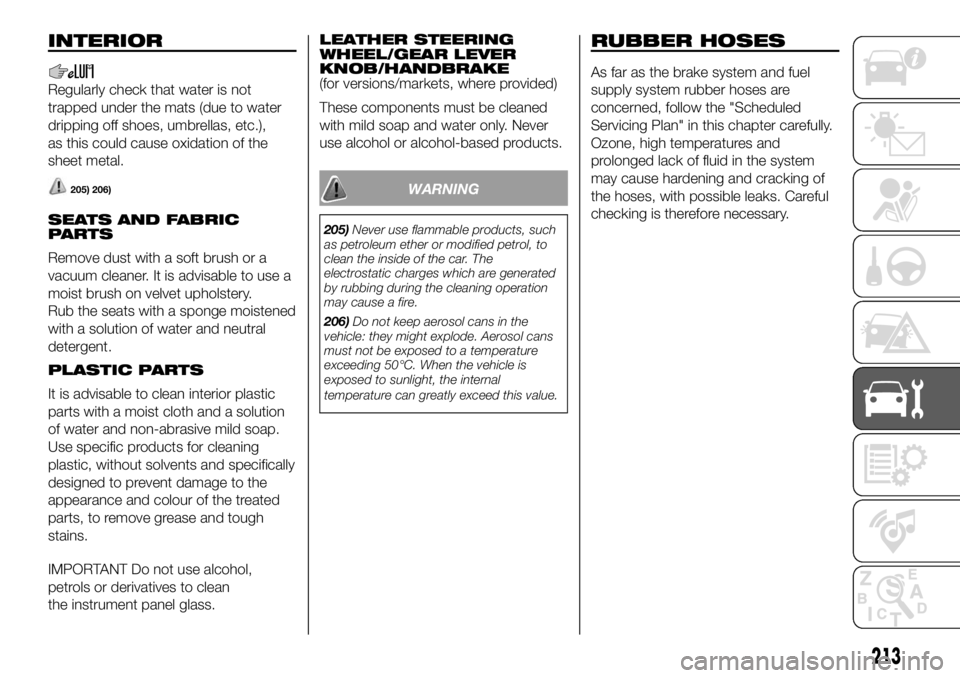
INTERIOR
Regularly check that water is not
trapped under the mats (due to water
dripping off shoes, umbrellas, etc.),
as this could cause oxidation of the
sheet metal.
205) 206)
SEATS AND FABRIC
PARTS
Remove dust with a soft brush or a
vacuum cleaner. It is advisable to use a
moist brush on velvet upholstery.
Rub the seats with a sponge moistened
with a solution of water and neutral
detergent.
PLASTIC PARTS
It is advisable to clean interior plastic
parts with a moist cloth and a solution
of water and non-abrasive mild soap.
Use specific products for cleaning
plastic, without solvents and specifically
designed to prevent damage to the
appearance and colour of the treated
parts, to remove grease and tough
stains.
IMPORTANT Do not use alcohol,
petrols or derivatives to clean
the instrument panel glass.LEATHER STEERING
WHEEL/GEAR LEVER
KNOB/HANDBRAKE
(for versions/markets, where provided)
These components must be cleaned
with mild soap and water only. Never
use alcohol or alcohol-based products.
WARNING
205)Never use flammable products, such
as petroleum ether or modified petrol, to
clean the inside of the car. The
electrostatic charges which are generated
by rubbing during the cleaning operation
may cause a fire.
206)Do not keep aerosol cans in the
vehicle: they might explode. Aerosol cans
must not be exposed to a temperature
exceeding 50°C. When the vehicle is
exposed to sunlight, the internal
temperature can greatly exceed this value.
RUBBER HOSES
As far as the brake system and fuel
supply system rubber hoses are
concerned, follow the "Scheduled
Servicing Plan" in this chapter carefully.
Ozone, high temperatures and
prolonged lack of fluid in the system
may cause hardening and cracking of
the hoses, with possible leaks. Careful
checking is therefore necessary.
213
Page 300 of 304

Fluids and lubricants...............248
Fog lights...........................32
Follow Me Home device.............29
Front airbags......................111
Front airbag driver's side.......111
Manually deactivating the front
airbag and side bag............112
Passenger side front airbag.....112
Front light clusters.................152
Front roof light
(changing a bulb)................157
Fuel consumption..................251
Fuel cut-off switch.................185
Fuel tank cap......................133
Fuses (replacement)................158
Gateway fms module..............171
Gear Shift Indicator..................56
Hazard warning lights...............32
HBA (Hydraulic Brake Assist)
system...........................87
HBA (system).......................87
Head restraints
Front ............................46
Headlight alignment corrector.......30
Headlight washers...................36
Headlights
Headlight alignment
corrector........................30
Light beam alignment............30
Heated rear window.................33Heating and ventilation..............37
Heating and ventilation controls......38
Hill Descent.........................88
Hill Descent Control System.........88
Hill Holder (system)..................86
Hill Holder system...................86
Identification data..................215
Ignition switch.......................10
Independent additional heater........40
Inflation pressure...................226
Inflation procedure.................181
Instrument panel....................52
Interior.............................213
Interior fittings.......................47
Isofix child restraint systems
(setup)
Arrangement possibilities for
child restraint system on seats
of vehicle......................107
Jump starting.....................183
Lifting the vehicle..................209
Light beam alignment................30
Light bulbs
Bulbs types....................150
Lights off............................27
Loading advice.....................140
Main beam headlights..............28
Maintenance and care - regular
checks..........................190Maintenance and care -
Scheduled Servicing.............190
Maintenance and care -
scheduled servicing plan.........192
Manually deactivating the front
airbag and side bag.............112
Moving footboard...................16
MSR (System).......................85
MSR system........................85
Multifunction display
Control buttons..................57
Setup menu.....................58
Nozzles...........................209
Number plate lights................156
On-board instruments..............52
Parking lights.......................29
Parking sensors....................128
Performance.......................237
Pollen filter.........................206
Power Socket.......................47
Power steering.....................222
Power steering fluid................203
Pre-tensioners......................98
Prolonged vehicle inactivity.........147
Radio.............................266
Rain sensor.........................35
Rear door with two wings............15
Rear fog lights.......................32
Rear footboard......................16
INDEX
Page 303 of 304
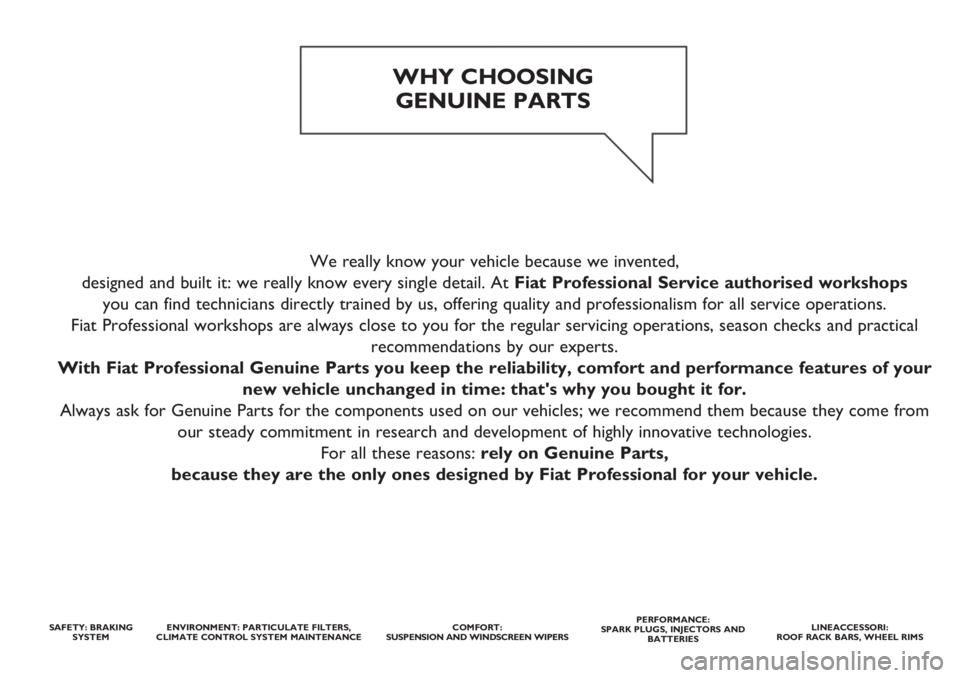
We really know your vehicle because we invented,
designed and built it: we really know every single detail. At Fiat Professional Service authorised workshops
you can find technicians directly trained by us, offering quality and professionalism for all service operations.
Fiat Professional workshops are always close to you for the regular servicing operations, season checks and practical
recommendations by our experts.
With Fiat Professional Genuine Parts you keep the reliability, comfort and performance features of your
new vehicle unchanged in time: that's why you bought it for.
Always ask for Genuine Parts for the components used on our vehicles; we recommend them because they come from
our steady commitment in research and development of highly innovative technologies.
For all these reasons: rely on Genuine Parts,
because they are the only ones designed by Fiat Professional for your vehicle.
WHY CHOOSING
GENUINE PARTS
SAFETY: BRAKING
SYSTEMENVIRONMENT: PARTICULATE FILTERS,
CLIMATE CONTROL SYSTEM MAINTENANCECOMFORT:
SUSPENSION AND WINDSCREEN WIPERSPERFORMANCE:
SPARK PLUGS, INJECTORS AND
BATTERIESLINEACCESSORI:
ROOF RACK BARS, WHEEL RIMS